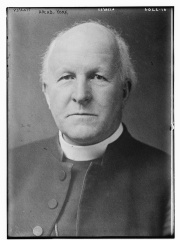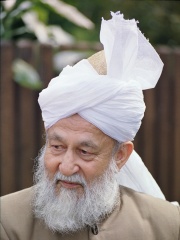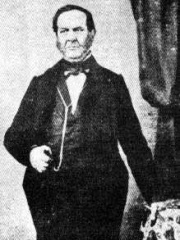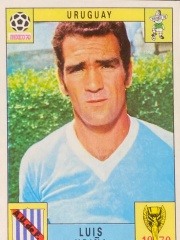RELIGIOUS FIGURE
Pedro Ignacio Wolcan Olano
1953 - Today

 Pedro Ignacio Wolcan Olano
Pedro Ignacio Wolcan Olano
Pedro Ignacio Wolcan Olano is from June 19, 2018 the bishop of Tacuarembó. Read more on Wikipedia
His biography is available in 17 different languages on Wikipedia (up from 16 in 2024). Pedro Ignacio Wolcan Olano is the 2,976th most popular religious figure (up from 3,014th in 2024), the 236th most popular biography from Uruguay (up from 281st in 2019) and the 3rd most popular Uruguayan Religious Figure.
Memorability Metrics
Page views of Pedro Ignacio Wolcan Olano by language
Among RELIGIOUS FIGURES
Among religious figures, Pedro Ignacio Wolcan Olano ranks 2,976 out of 3,187. Before him are Bilal Philips, Domenico Battaglia, François Bustillo, Cosmo Gordon Lang, Alvin Sargent, and José Humberto Quintero Parra. After him are Aimee Semple McPherson, Thirteen Assyrian Fathers, Sajida al-Rishawi, Mirza Tahir Ahmad, Wenceslao Padilla, and Demophilus of Constantinople.
Most Popular Religious Figures in Wikipedia
Go to all RankingsBilal Philips
1947 - Present
HPI: 52.97
Rank: 2,970
Domenico Battaglia
1963 - Present
HPI: 52.96
Rank: 2,971
François Bustillo
1968 - Present
HPI: 52.94
Rank: 2,972
Cosmo Gordon Lang
1864 - 1945
HPI: 52.93
Rank: 2,973
Alvin Sargent
1927 - 2019
HPI: 52.93
Rank: 2,974
José Humberto Quintero Parra
1902 - 1984
HPI: 52.88
Rank: 2,975
Pedro Ignacio Wolcan Olano
1953 - Present
HPI: 52.87
Rank: 2,976
Aimee Semple McPherson
1890 - 1944
HPI: 52.85
Rank: 2,977
Thirteen Assyrian Fathers
HPI: 52.79
Rank: 2,978
Sajida al-Rishawi
1970 - 2015
HPI: 52.76
Rank: 2,979
Mirza Tahir Ahmad
1928 - 2003
HPI: 52.76
Rank: 2,980
Wenceslao Padilla
1949 - 2018
HPI: 52.74
Rank: 2,981
Demophilus of Constantinople
HPI: 52.73
Rank: 2,982
Contemporaries
Among people born in 1953, Pedro Ignacio Wolcan Olano ranks 459. Before him are Mehdi Cerbah, Sharon Robinson, Giannina Braschi, Vlastimil Petržela, Katsuya Okada, and Dimitris Avramopoulos. After him are John Edwards, Paco Herrera, Vijay Amritraj, Lamberto Leoni, James Smith, and Ellen S. Baker.
Others Born in 1953
Go to all RankingsMehdi Cerbah
SOCCER PLAYER
1953 - 2021
HPI: 53.03
Rank: 453
Sharon Robinson
SINGER
1953 - Present
HPI: 53.02
Rank: 454
Giannina Braschi
WRITER
1953 - Present
HPI: 53.02
Rank: 455
Vlastimil Petržela
SOCCER PLAYER
1953 - Present
HPI: 53.00
Rank: 456
Katsuya Okada
POLITICIAN
1953 - Present
HPI: 53.00
Rank: 457
Dimitris Avramopoulos
POLITICIAN
1953 - Present
HPI: 52.89
Rank: 458
Pedro Ignacio Wolcan Olano
RELIGIOUS FIGURE
1953 - Present
HPI: 52.87
Rank: 459
John Edwards
POLITICIAN
1953 - Present
HPI: 52.86
Rank: 460
Paco Herrera
SOCCER PLAYER
1953 - Present
HPI: 52.81
Rank: 461
Vijay Amritraj
ACTOR
1953 - Present
HPI: 52.81
Rank: 462
Lamberto Leoni
RACING DRIVER
1953 - Present
HPI: 52.80
Rank: 463
James Smith
BOXER
1953 - Present
HPI: 52.77
Rank: 464
Ellen S. Baker
PHYSICIAN
1953 - Present
HPI: 52.76
Rank: 465
In Uruguay
Among people born in Uruguay, Pedro Ignacio Wolcan Olano ranks 236 out of 444. Before him are Juan Rodríguez (1928), Francisco Acuña de Figueroa (1790), Roberto Sosa (1935), Maxi Pereira (1984), Jorge Manicera (1938), and Cristhian Stuani (1986). After him are Luis Ubiña (1940), Lucas Torreira (1996), Fabián O'Neill (1973), Alberto Héber Usher (1918), Luisa Cuesta (1920), and Álvaro Pereira (1985).
Others born in Uruguay
Go to all RankingsJuan Rodríguez
ATHLETE
1928 - 2019
HPI: 53.25
Rank: 230
Francisco Acuña de Figueroa
WRITER
1790 - 1862
HPI: 53.04
Rank: 231
Roberto Sosa
SOCCER PLAYER
1935 - 2008
HPI: 53.01
Rank: 232
Maxi Pereira
SOCCER PLAYER
1984 - Present
HPI: 52.97
Rank: 233
Jorge Manicera
SOCCER PLAYER
1938 - 2012
HPI: 52.94
Rank: 234
Cristhian Stuani
SOCCER PLAYER
1986 - Present
HPI: 52.88
Rank: 235
Pedro Ignacio Wolcan Olano
RELIGIOUS FIGURE
1953 - Present
HPI: 52.87
Rank: 236
Luis Ubiña
SOCCER PLAYER
1940 - 2013
HPI: 52.86
Rank: 237
Lucas Torreira
SOCCER PLAYER
1996 - Present
HPI: 52.77
Rank: 238
Fabián O'Neill
SOCCER PLAYER
1973 - 2022
HPI: 52.73
Rank: 239
Alberto Héber Usher
POLITICIAN
1918 - 1981
HPI: 52.71
Rank: 240
Luisa Cuesta
SOCIAL ACTIVIST
1920 - 2018
HPI: 52.59
Rank: 241
Álvaro Pereira
SOCCER PLAYER
1985 - Present
HPI: 52.54
Rank: 242
Among RELIGIOUS FIGURES In Uruguay
Among religious figures born in Uruguay, Pedro Ignacio Wolcan Olano ranks 3. Before him are Daniel Sturla (1959), and Antonio María Barbieri (1892).
Daniel Sturla
1959 - Present
HPI: 58.12
Rank: 1
Antonio María Barbieri
1892 - 1979
HPI: 57.67
Rank: 2
Pedro Ignacio Wolcan Olano
1953 - Present
HPI: 52.87
Rank: 3






































